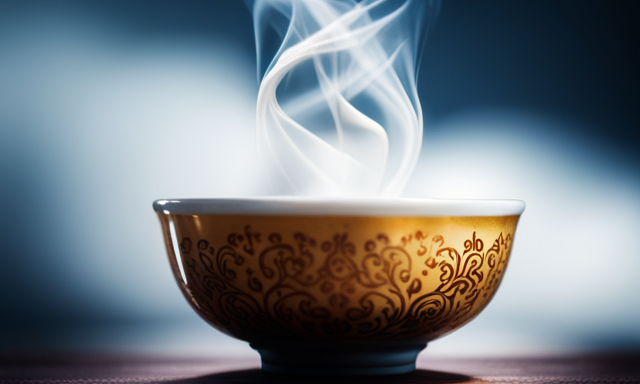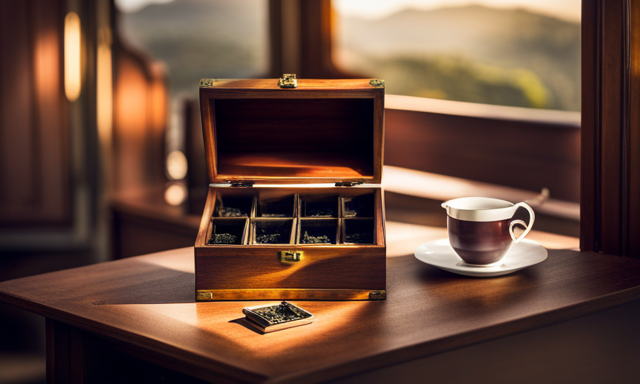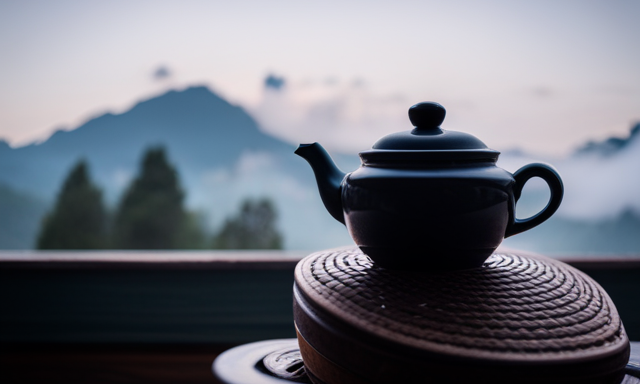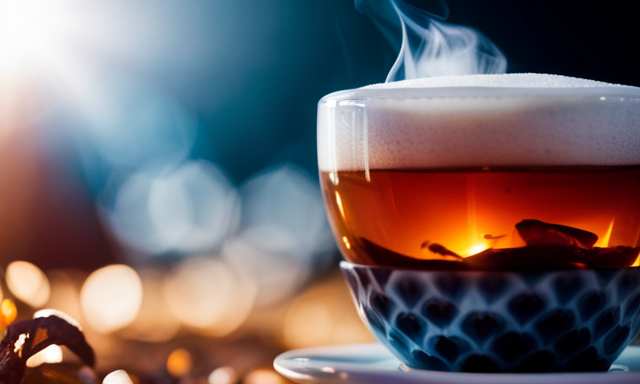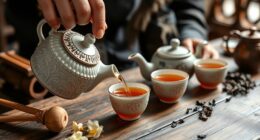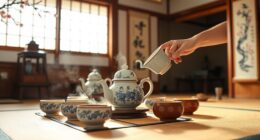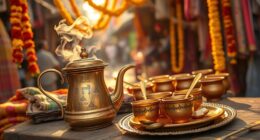Did you know that oolong tea is considered the most diverse and nuanced of all tea categories? With its extensive range of flavors and potential health benefits, oolong tea is truly an exceptional beverage. As a tea lover, I am constantly captivated by the distinctive qualities and origins of oolong tea.
In this article, I will delve into the history, flavor profiles, processing methods, and different types of oolong tea. I will also explore popular blends and flavors, as well as provide insights on how to pair oolong tea with food.
Additionally, I will uncover the rituals and traditions associated with this tea, and share information on where to buy and enjoy this delightful beverage. So, if you’re curious about what kind of tea oolong is and want to expand your knowledge on this fascinating drink, keep reading!
Key Takeaways
- Oolong tea is a partially fermented tea that originated in ancient China during the Ming Dynasty.
- It undergoes a unique process of withering, oxidation, and roasting to achieve its distinct flavor profiles.
- Oolong tea offers a harmonious blend of floral, fruity, roasted, earthy, creamy, and buttery notes.
- It has numerous health benefits, including immune support, weight management, and heart health promotion.
History and Origins of Oolong Tea
The history and origins of oolong tea are fascinating. Oolong tea has a long and prestigious history of cultivation, dating back to ancient China. It is believed that oolong tea was first produced during the Ming Dynasty, around the 16th century.
The tea leaves are carefully hand-picked and then undergo a unique process of withering, oxidation, and roasting, which gives oolong tea its distinct flavor and aroma.
Oolong tea holds great cultural significance in Chinese traditions and is often associated with elegance and sophistication. The tea is not only enjoyed for its exquisite taste but also for its health benefits.
Now, let’s delve into the subsequent section about the unique flavor profiles of oolong tea.
The Unique Flavor Profiles of Oolong Tea
When it comes to the unique flavor profiles of oolong tea, there are three key points that stand out to me.
Firstly, oolong tea often boasts floral and fruity notes, which add a delightful sweetness and complexity to the brew.
Secondly, the roasted and earthy tones of oolong tea bring a rich and comforting depth to the flavor profile, making it a perfect choice for those seeking a more robust tea experience.
Lastly, oolong tea can also exhibit creamy and butter-like nuances, providing a smooth and velvety texture that enhances the overall drinking experience.
In summary, the flavor profiles of oolong tea are truly a harmonious blend of floral and fruity notes, roasted and earthy tones, as well as creamy and butter-like nuances, making it a truly unique and enjoyable tea to savor.
Floral and Fruity Notes
Indulge in the delightful experience of savoring oolong tea and be enchanted by its captivating floral and fruity notes.
Oolong tea is renowned for its exquisite taste, which is characterized by a harmonious blend of floral and fruity flavors. The floral notes range from delicate and sweet to bold and aromatic, adding a refreshing and uplifting quality to each sip.
Meanwhile, the fruity undertones provide a subtle sweetness that complements the overall flavor profile.
Not only does oolong tea offer a delightful taste experience, but it also boasts numerous health benefits. Rich in antioxidants and polyphenols, this tea can help boost the immune system, improve digestion, and promote overall well-being.
Transitioning into the subsequent section about roasted and earthy tones, oolong tea also offers a unique combination of these flavors, adding depth and complexity to its character.
Roasted and Earthy Tones
Immerse yourself in the rich warmth of oolong tea. Its roasted and earthy tones will transport you to a cozy fireside retreat.
Oolong tea is known for its distinct flavor profile. This is achieved through various roasting techniques. The leaves are carefully roasted to bring out the tea’s unique characteristics. This creates a depth of flavor that sets it apart from other types of tea.
When compared to floral and fruity notes, oolong tea’s roasted and earthy tones provide a more robust and grounded experience. The toasty aroma and nutty undertones add a comforting element to each sip.
As we transition into the next section, we will explore the creamy and butter-like nuances that further enhance the complexity of oolong tea.
Creamy and Butter-like Nuances
Transport yourself to a cozy fireside retreat with the creamy and butter-like nuances that enhance the complexity of oolong tea. This delightful tea variety boasts a range of flavors that are reminiscent of decadent creams and velvety butter. The creamy tea flavors are achieved through a precise combination of tea leaves and processing techniques. The result is a smooth and luscious cup of tea that leaves a pleasant, lingering aftertaste.
To truly appreciate the creamy and buttery tea profiles of oolong tea, it’s important to note the following sub-lists:
-
Varieties: Milk oolong, also known as Jin Xuan, is famed for its milky aroma and taste. Another popular choice is the Tie Guan Yin, which exhibits a rich buttery undertone.
-
Brewing: To bring out the creamy flavors, it’s recommended to use water at 195°F and steep the tea for about 3-4 minutes.
These details add depth to the tea-drinking experience, making it even more enjoyable and relatable.
As we delve into the health benefits of oolong tea, you’ll discover how its creamy and butter-like nuances contribute to overall well-being.
The Health Benefits of Oolong Tea
Enjoy the soothing aroma of oolong tea as it gracefully dances across your senses, transporting you to a state of tranquility while unlocking its numerous health benefits.
Oolong tea is not only a delight to the taste buds but also offers a range of advantages for your well-being. Packed with antioxidants, it helps boost your immune system and fight off free radicals, reducing the risk of chronic diseases.
Additionally, oolong tea has been associated with weight management, as it can enhance metabolism and aid in burning fat. Furthermore, this tea is known to promote heart health by reducing cholesterol levels and improving blood circulation.
Its unique brewing techniques and partially fermented leaves contribute to its rich flavor and healthful properties. Moving forward, let’s explore how oolong tea is processed and what makes it distinct.
How Oolong Tea is Processed
When it comes to processing oolong tea, there are three key steps that are crucial in achieving its unique flavor and characteristics.
First, the leaves undergo withering and wilting, where they are carefully spread out to remove excess moisture.
Next, the leaves go through oxidation and fermentation, which is a crucial step in developing the tea’s distinctive taste.
Finally, the leaves are fired and dried to stop the oxidation process and preserve the flavor.
These steps play a vital role in the processing of oolong tea, resulting in a complex and flavorful brew.
Withering and Wilting
During the withering and wilting process, you’ll witness the leaves of oolong tea gently shrivel, releasing their delicate aroma and setting the stage for a remarkable brew.
Withering is a crucial step in tea processing that involves carefully manipulating the moisture content of the leaves. There are different withering techniques used, such as indoor withering or outdoor withering, which depend on the desired flavor profile of the tea.
After withering, the leaves are left to wilt, allowing natural enzymes to activate and initiate the oxidation process. This wilting process is essential for developing the unique characteristics and flavors of oolong tea.
As the leaves wilt, their cell walls break down, releasing enzymes that react with the oxygen in the air. This transition into oxidation and fermentation is what ultimately transforms the tea leaves into the exquisite oolong tea we know and love.
Oxidation and Fermentation
After the leaves have withered and wilted, their transformation begins, as natural enzymes activate and initiate the oxidation and fermentation process, creating a symphony of flavors and aromas that dance on the palate. During the oxidation process, the tea leaves are spread out and exposed to air, allowing chemical reactions to occur. This step is crucial in determining the flavor profile of the oolong tea. The level of oxidation can range from light to dark, resulting in a spectrum of tastes that can be floral, fruity, or even toasty. The next stage is tea fermentation, where the partially oxidized leaves are carefully monitored to achieve the desired level of fermentation. This intricate process allows the tea to develop its unique characteristics. Moving on to the subsequent section about firing and drying, the tea leaves are subjected to heat to halt the oxidation and preserve the flavors attained.
Firing and Drying
After the process of oxidation and fermentation, the next step in producing oolong tea is firing and drying. Firing techniques play a crucial role in determining the final flavor and aroma of the tea.
Different firing techniques can result in variations in taste, ranging from floral and fruity to toasty and nutty. The firing process involves exposing the tea leaves to high heat, which stops the oxidation process and helps to preserve the tea’s natural flavors.
Following firing, the leaves undergo a drying process to remove any remaining moisture. This step is essential for enhancing the tea’s shelf life and ensuring its quality.
In summary, firing and drying are critical stages in the production of oolong tea, influencing its taste and longevity.
Moving forward, let’s explore the different types of oolong tea.
Different Types of Oolong Tea
If you’re looking to explore the world of oolong tea, there are various types that will delight your taste buds. Oolong tea comes in a range of flavors and styles, each with its own unique characteristics. From light and floral to rich and roasted, there is an oolong tea to suit every palate. To help you navigate through the different types, here is a table highlighting some popular varieties:
| Type of Oolong Tea | Flavor Profile | Brewing Method |
|---|---|---|
| Tie Guan Yin | Floral, fruity | Gongfu |
| Da Hong Pao | Roasted, nutty | Gongfu |
| Oriental Beauty | Honey, fruity | Western |
| Milk Oolong | Creamy, sweet | Western |
| Wuyi Rock | Smoky, earthy | Gongfu |
Now that you have an idea of the diverse flavors and brewing methods, let’s move on to exploring the art of brewing techniques for oolong tea.
Brewing Techniques for Oolong Tea
When it comes to brewing oolong tea, two key factors to consider are water temperature and steeping time. The ideal water temperature for oolong tea is typically between 185°F and 205°F, which allows for the perfect balance of flavor extraction. Steeping time can vary depending on personal preference, but generally ranges from 1 to 5 minutes.
There are two main brewing techniques for oolong tea: Gongfu Cha and Western-style brewing. Gongfu Cha involves using a small teapot and multiple short infusions to bring out the complex flavors of the tea. On the other hand, Western-style brewing uses a larger teapot or infuser and longer steeping times for a more convenient and casual approach.
One of the unique characteristics of oolong tea is its ability to be infused multiple times. This allows for a full flavor experience, as the tea leaves gradually unfold and release their flavors with each infusion. By adjusting the steeping time and water temperature for each subsequent infusion, you can explore the different layers and nuances of the tea.
Water Temperature and Steeping Time
To get the perfect cup of oolong tea, steep it in hot water for a few minutes until it reaches a rich amber color. The water temperature and steeping time play crucial roles in extracting the flavors and health benefits of oolong tea.
Oolong tea is best brewed with water that is around 190-200 degrees Fahrenheit, which is just below boiling point. Steeping oolong tea for about 3-5 minutes allows the leaves to unfurl and release their complex flavors. This brewing technique maximizes the tea’s aroma and taste while preserving its health benefits, such as boosting metabolism and aiding digestion.
Transitioning into the subsequent section about ‘gongfu cha vs. western-style brewing,’ it is important to note that the steeping method can also influence the overall tea experience.
Gongfu Cha vs. Western-style Brewing
For a more immersive tea experience, try experimenting with the traditional gongfu cha method or the simpler western-style brewing.
Gongfu cha, which translates to ‘making tea with skill,’ is a Chinese tea brewing method that involves using a small teapot, multiple short infusions, and precise brewing parameters. This method allows for a more nuanced and complex flavor profile to be extracted from the tea leaves.
On the other hand, western-style brewing involves steeping the tea leaves in a larger teapot or a cup for a longer period of time. This method is convenient and produces a bolder, stronger flavor.
The advantage of gongfu cha is that it allows for multiple infusions, each with its own unique flavors. This technique brings out the full flavor potential of oolong tea and allows you to appreciate its complexity.
Transitioning to the next section, let’s discuss how multiple infusions enhance the flavor even further.
Multiple Infusions for Full Flavor
Experience the full flavor potential of your favorite tea by indulging in multiple infusions. This practice unlocks a world of complexity and delight, particularly with oolong tea and its unique characteristics. Through multiple infusions, the flavor profile of oolong tea evolves and intensifies. It reveals different layers and nuances with each steeping.
To achieve the best results, it’s important to employ flavor extraction techniques. This includes adjusting water temperature and steeping time. By experimenting with these variables, you can discover the ideal combination that brings out the full potential of your oolong tea.
The art of multiple infusions allows you to fully appreciate the intricate flavors and aromas that oolong tea has to offer. Now, let’s delve into the world of popular oolong tea blends and flavors.
Popular Oolong Tea Blends and Flavors
When it comes to popular Oolong tea blends and flavors, there are a few that stand out for their unique taste profiles.
One such blend is Peach Oolong, which combines the natural sweetness of peaches with the floral notes of Oolong tea.
Another popular blend is Milk Oolong, known for its creamy and smooth texture that is reminiscent of milk.
Lastly, there is Coconut Oolong, a tropical blend that infuses the rich and nutty flavor of coconut with the delicate taste of Oolong tea.
Peach Oolong
Peach Oolong is like a juicy peach and a sophisticated oolong had a delightful lovechild. This blend combines the natural sweetness of peaches with the unique flavor profile of oolong tea. The result is a refreshing and aromatic brew that is both fruity and earthy.
To bring out the best of this tea, it is important to use the right brewing techniques. Steep the leaves in water that is around 190°F for about 3 minutes to achieve the perfect balance of flavors. The peach flavor will be enhanced without overpowering the delicate oolong notes.
As you sip this delightful infusion, you’ll experience the luscious taste of ripe peaches followed by the smooth and slightly nutty undertones of oolong.
Now, let’s move on to the next section and explore the wonders of milk oolong.
Milk Oolong
Indulge in the creamy richness of Milk Oolong, a tea that captivates with its velvety texture and tantalizing aroma.
Milk Oolong, also known as Jin Xuan, is a unique type of oolong tea that originated in Taiwan. The tea leaves are carefully handpicked and processed to create a tea that is smooth, sweet, and creamy, reminiscent of milk or cream.
This tea is not actually flavored with milk, but rather, it gets its creamy taste from the natural compounds found in the tea leaves themselves.
Milk Oolong is best enjoyed by following the traditional oolong tea rituals, such as steeping the leaves multiple times to fully appreciate its complex flavors.
Now, let’s explore the next delightful oolong tea variety: coconut oolong.
Coconut Oolong
Coconut Oolong, with its tropical essence, invites you to savor a delightful blend of flavors that may challenge your preconceived notions. This unique tea combines the smoothness of oolong with the sweet aroma of coconut infusion, creating a truly indulgent experience.
Not only does it taste heavenly, but Coconut Oolong also offers numerous health benefits. Oolong tea is known for its metabolism-boosting properties and ability to aid in weight management. Additionally, the natural antioxidants found in both oolong and coconut can support a healthy immune system and promote overall well-being.
So, while you enjoy the rich, creamy taste of Coconut Oolong, you can also feel good about its positive impact on your health.
Now, let’s explore the exciting world of pairing oolong tea with food.
Pairing Oolong Tea with Food
Enhance your dining experience by exploring the delightful harmony of flavors when you pair Oolong Tea with your favorite dishes. Tea pairing is an art that brings out the best in both the tea and the food, creating a memorable culinary experience. Oolong Tea, with its unique flavor notes, is the perfect companion for a wide range of cuisines.
To help you navigate the world of Oolong Tea pairing, here is a table that showcases some popular food pairings:
| Food | Oolong Tea Pairing | Flavor Notes |
|---|---|---|
| Roasted duck | Oriental Beauty Oolong | Sweet, honey, floral |
| Grilled seafood | Tie Guan Yin Oolong | Creamy, buttery, floral |
| Spicy stir-fry | Da Hong Pao Oolong | Toasted, nutty, smoky |
| Dark chocolate dessert | Wuyi Rock Oolong | Rich, roasted, chocolatey |
By understanding the unique flavor profiles of different Oolong Teas, you can create a harmonious pairing that elevates your dining experience. Now, let’s delve into the fascinating world of Oolong tea rituals and traditions.
Oolong Tea Rituals and Traditions
Immerse yourself in the rich cultural heritage of Oolong Tea by exploring its captivating rituals and traditions, which add a touch of elegance and depth to your tea-drinking experience.
Oolong tea ceremonies hold great cultural significance and are often seen as a form of art. These ceremonies are deeply rooted in Chinese and Taiwanese culture, with each step carefully choreographed to create a harmonious and serene atmosphere.
The preparation and serving of oolong tea are done with utmost precision and grace, enhancing the flavors and aromas of the tea. The rituals associated with oolong tea not only celebrate the beverage itself but also symbolize respect, gratitude, and mindfulness towards nature and the people involved in its production.
Discover the beauty and grace of oolong tea ceremonies, and let them transport you to a world of tranquility and appreciation.
Now, let’s delve into where to buy and enjoy oolong tea.
Where to Buy and Enjoy Oolong Tea
Indulge in the unique experience of discovering the perfect place to purchase and savor the exquisite flavors of this beloved tea variety. When it comes to buying options for oolong tea, there are plenty of choices available. Here are three top-notch brands that offer the best oolong tea:
-
Teavana: Known for their high-quality teas, Teavana offers a wide selection of oolong varieties, ranging from light and floral to rich and robust.
-
Harney & Sons: With a reputation for excellence, Harney & Sons source their oolong teas from the finest tea gardens around the world. Their teas are known for their exceptional flavor and aroma.
-
DAVIDsTEA: This popular tea retailer offers a diverse range of oolong teas, including flavored options for those looking for a unique twist.
Whether you prefer shopping online or visiting a brick-and-mortar store, these brands provide excellent options for purchasing and enjoying the delightful taste of oolong tea.
Frequently Asked Questions
What are the different grades of oolong tea?
There are various grades of oolong tea, each offering different flavors and requiring specific brewing techniques. Let me enlighten you on these exquisite grades and how they can elevate your tea experience.
Are there any potential side effects or risks associated with drinking oolong tea?
There are no significant side effects or risks associated with drinking oolong tea. It actually offers potential health benefits, such as promoting weight loss and improving heart health. To maximize these benefits, it is recommended to consume 2-3 cups of oolong tea per day.
Can oolong tea help with weight loss or maintaining a healthy weight?
Oolong tea can aid in weight loss and weight management due to its metabolism-boosting properties. It has been shown to increase fat oxidation and reduce body fat. Some recommended brands include Tie Guan Yin, Da Hong Pao, and Dong Ding.
Is oolong tea suitable for people with specific dietary restrictions, such as vegetarians or vegans?
Oolong tea is suitable for vegetarians and vegans as it is made from the leaves of the Camellia sinensis plant. It also offers potential health benefits, such as aiding in weight loss and maintaining a healthy weight.
How does the caffeine content in oolong tea compare to other types of tea or coffee?
Oolong tea has a moderate amount of caffeine, making it a great alternative to coffee. Compared to other teas, oolong falls in the middle range. It also offers numerous health benefits for overall well-being.
Conclusion
In conclusion, I must say that oolong tea is truly a remarkable beverage. Its rich history and unique flavor profiles make it a standout in the world of tea.
With its numerous health benefits and the careful processing it undergoes, oolong tea is a true testament to the art of tea making.
Whether you prefer a classic oolong or one of the many blends and flavors available, there is something for everyone to enjoy.
So, why not indulge in a cup of oolong tea today and experience its magic for yourself?

